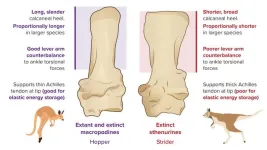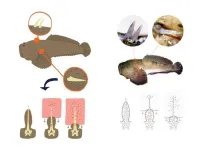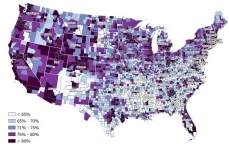(Press-News.org) BOSTON—Childhood adversity—circumstances that threaten to a child’s physical or psychological well-being--has long been associated with poorer physical and mental health throughout life, such as greater risks of developing cardiac disease, cancer, or depression. It remains unclear, however, when and how the effects of childhood adversity become biologically embedded to influence health outcomes in children, adolescents, and adults.
A team of researchers at Massachusetts General Hospital (MGH), a founding member of Mass General Brigham (MGB), previously showed that exposure to adversity between ages 3 to 5 has a significant effect on the epigenome of children at age 7, altering biological processes that may be linked to deleterious long-term health outcomes.
Now, in a new study published in The Lancet Child & Adolescent Health, these researchers demonstrate how the timing of exposures to adversities in early childhood affects epigenetic patterns in adolescence.
“To our knowledge, this is the first study to examine the time-varying influences of childhood adversity on epigenetic mechanisms from childhood to adolescence,” says first author Alexandre A. Lussier, PhD, research fellow at MGH and Instructor in Psychology at Harvard Medical School. “We wanted to determine if the epigenetic profiles associated with adversity that we observed in children at age 7 persisted into adolescence and whether the timing of exposure to adversity influenced epigenetic trajectories across development.”
The investigators studied changes in epigenetic mechanisms—specifically DNA methylation (DNAm)—in children enrolled in the Avon Longitudinal Study of Parents and Children, a 30-year-long prospective birth cohort from the United Kingdom that has followed 13,988 children from before birth through early adulthood. The unique study has collected multiple measures of childhood adversity and epigenetic profiles across the lives of participants.
“Epigenetics acts at the intersection between a person’s genome, which is set at conception and is stable, and the environment, which is always changing,” explains Lussier. “Epigenetic mechanisms, which are sensitive to environmental factors, function like a dimmer switch on our genes, controlling how much of the gene is expressed and how much is turned off over time.”
Measuring levels of DNAm captures information about how genes are expressed, and these epigenetic signatures could serve as a biological indicator or early warning sign of disease processes, helping to identify people at greater risk for future disease.
In this study, the researchers analyzed DNAm at three time points—at birth from cord blood, and at ages 7 and 15 from blood—and investigated the timing of exposure to seven adversity types, including neglect, different types of abuse, poverty, and family dysfunction.
“These data allowed us to investigate whether exposure to childhood adversity during certain periods in development had greater impacts on biological processes and how exposures during these sensitive periods influence epigenetic trajectories across development in the same children,” says Lussier.
The researchers found that children exposed to adversity between the ages of 3 through 5 had the greatest differences in DNAm levels at age 15 compared with adolescents who had not experienced childhood adversity.
“The preschool period may be a sensitive period for the biological embedding of childhood adversity that manifests in adolescence”, says senior author Erin C. Dunn, ScD, MPH, Associate Investigator, Center for Genomic Medicine at MGH and Associate Professor of Psychiatry at Harvard Medical School.
In particular, exposures to one-adult households (single-parent families) were linked to more changes in DNAm in adolescence than other types of childhood adversity, such as maternal depression, financial hardship, or abuse.
They also found that DNAm patterns previously identified in children exposed to adversity did not persist into adolescence. And at age 15, there were epigenetic changes not present earlier in development. These findings may explain why there are both immediate and latent manifestations of disease among people with histories of childhood adversity.
“These findings are important because they suggest our epigenome may be dynamic across our lifespan,” says Dunn. “In other words, our bodies adapt, in good ways and bad, in response to our life experiences. If true, then interventions could be mounted to help reverse negative epigenetic changes that occur in response to adversity.”
Hundreds of previous human studies have shown links between childhood adversity, DNAm, and poor health outcomes, but more research is needed to determine whether epigenetic changes are one of the underlying mechanisms that influence long-term physical and mental health, says Lussier.
“Our study is a first step in demonstrating a relationship between the timing of childhood adversity and epigenetic changes. But if our results are replicated, epigenetic patterns could potentially have important clinical implications for early risk prediction, disease prognosis, responses to therapy, and critical timing for interventions to buffer the deleterious effects of childhood adversity may have greater success.”
As one of the next steps for this research, the investigators are currently studying whether DNAm changes affect how cells function by using in vitro cell culture models.
Co-authors include Andrew J. Simpkin, Andrew D.A.C. Smith, Matthew J. Suderman, Esther Walton, Caroline L. Relton, and Kerry J. Ressler.
Major funding for this study was provided by the National Institute of Mental Health of the National Institutes of Health.
About the Massachusetts General Hospital
Massachusetts General Hospital, founded in 1811, is the original and largest teaching hospital of Harvard Medical School. The Mass General Research Institute conducts the largest hospital-based research program in the nation, with annual research operations of more than $1 billion and comprises more than 9,500 researchers working across more than 30 institutes, centers and departments. In July 2022, Mass General was named #8 in the U.S. News & World Report list of "America’s Best Hospitals." MGH is a founding member of the Mass General Brigham healthcare system.
END
Timing of childhood adversity is associated with unique epigenetic patterns in adolescents
Study’s findings have potential implications for assessing risk of adverse physical and mental health outcomes.
2023-06-14
ELSE PRESS RELEASES FROM THIS DATE:
Lockdown children played on, study finds, despite being stuck at home
2023-06-14
Children displayed a resilient capacity to continue playing during peak COVID-19, a study has found, even though their options to do so became more limited while under stay-at-home orders.
The research, by academics at the University of Cambridge, interviewed children themselves about their playing habits during the pandemic. Without disputing the consensus that COVID-19 impeded children’s healthy development, it does suggest that they were able to adapt their play habits to their changed circumstances.
Children largely expressed ...
Skipping evolution: some kangaroos didn’t hop, scientists explain
2023-06-14
Extinct kangaroos used alternative methods to their famous hop according to comprehensive analysis from University of Bristol and the University of Uppsala scientists.
Although hopping is regarded as a pinnacle of kangaroo evolution, the researchers highlight that other kinds of large kangaroos, in the not too distant past, likely moved in different ways such as striding on two legs or traversing on all fours.
In the review, published in Alcheringa: An Australasian Journal of Palaeontology, the team shows that there are other ways to be an evolutionary ...
Light pollution confuses coastal woodlouse
2023-06-14
Artificial night-time light confuses a colour-changing coastal woodlouse, new research shows.
The sea slater is an inch-long woodlouse that lives around the high-tide line and is common in the UK and Europe.
Sea slaters forage at night and can change colour to blend in and conceal themselves from predators.
The new study, by the University of Exeter, tested the effects of a single-point light source (which casts clear shadows) and “diffuse” light (similar to “skyglow” found near towns and cities).
While the single light did not interfere with the sea slaters’ camouflage, diffuse light caused them to turn ...
Giving birth outside of working hours in England is safe, suggests study
2023-06-14
A new study suggests that between 2005 and 2014, for almost all births in England, being born outside of working hours did not carry a significantly higher risk of death to the baby from anoxia (lack of oxygen) or trauma, when compared to births during working hours.
The finding runs contrary to an assumed, wider ‘weekend effect,’ with previously reported research suggesting a significantly higher risk of death for births outside of working hours or at weekends.
The current study from City, University of London ...
Brighter nights risk extinguishing glow-worm twinkle
2023-06-14
The bright lights of big cities are wonders of the modern world; intended to help us work, stay safe and enjoy the world around us long after the sun has set. While artificial light has been great for increasing human productivity, some nocturnal animals, and even people, pay a price for this illumination. From increasing the amount of time that predators are active to disrupting migrations, light pollution affects many animals; but how do animals that use their own luminescence to lure food or attract mates fair against this new, brighter background? Female common glow-worms (Lampyris noctiluca) emit a green glow from their abdomen to ...
Meat processing plants: What factors are critical for survival?
2023-06-13
URBANA, Ill. — Meat processing plants in the U.S. have garnered considerable public attention in recent years, often focusing on production and labor issues. The COVID-19 pandemic underscored the vulnerability of large, concentrated plants, as major shutdowns led to reduced output and higher meat prices for consumers.
Policy makers have launched initiatives at the state and federal levels to increase meat processing capacity and industry resilience, often favoring small and medium-sized plants. But little research exists to determine what factors make plants more likely to succeed. A new study from the University of ...
CHOP researchers develop universal MHC molecules that can be produced rapidly at scale
2023-06-13
Philadelphia, June 13, 2023— Class I major histocompatibility complex (MHC-I) proteins play an essential role in the immune system of all jawed vertebrates. The MHC-I displays peptide fragments of proteins from within the cell on the cell surface, “presenting” them to the immune system, which is constantly scanning the body for foreign or toxic antigens. When foreign peptides are identified, they trigger a cascade that allows cytotoxic T cells to eliminate intruders. This process has been exploited in the development of both vaccines ...
Peptide from venomous fish toxin controls lung inflammation in mice
2023-06-13
A molecule found in the venomous toadfish Thalassophryne nattereri has proved capable of controlling lung inflammation and could be the basis for a more effective asthma drug. The research was supported by FAPESP and conducted by scientists at Butantan Institute in São Paulo, Brazil. An article describing the results is published in the journal Cells.
A welter of fish species live in freshwater, seawater and a mixture of the two, and some of them are venomous. They have spines or stingers connected to venom glands, which ...
Residents in 'digital deserts' have fewer health care options
2023-06-13
Residents in rural counties with limited access to high-speed internet cannot take advantage of increasingly popular online health services.
A new study by the University of Cincinnati highlighted disparities in access to digital technology that could widen the gap in access to health care. The study found that socially vulnerable communities in the United States face more barriers to adequate health care, live in areas with fewer health care resources and have less access to high-speed internet.
The study was published in the journal Mayo Clinic Proceedings: Digital Health.
The Biden Administration announced this year it will invest $73 million in outreach ...
Different genes are expressed at different stages during pregnancy, according to scientists
2023-06-13
We have a good understanding of how a woman’s external features can change during pregnancy, but scientists know surprisingly little about what biological changes occur internally.
A new Northwestern Medicine study, published June 5 in the journal Frontiers in Immunology, provides data about immune cells and biological changes (gene expression) in pregnant people at multiple timepoints before and during pregnancy. Using RNA sequencing and computational methods to estimate proportions of different activated types of immune cells in blood the team of scientists showed how pregnancy induces progressive changes in the maternal ...
LAST 30 PRESS RELEASES:
Pusan National University researchers discover faster, smarter heat treatment for lightweight magnesium metals
China’s 2024 Gastroenterology Report: marked progress in endoscopy quality and disease management
Pusan National University researchers uncover scalable method for ultrahigh-resolution quantum dot displays
Researchers use robotics to find potential new antibiotic among hundreds of metal complexes
Gut bacteria changes at the earliest stages of inflammatory bowel disease
Scientists develop new way to “listen in” on the brain’s hidden language
Brain research: “Pulse generators” grow and shrink as memories are formed
For teens, any cannabis use may have impact on emotional health, academic performance
School meals could unlock major gains for human and planetary health
Menopause hormone therapy does not appear to impact dementia risk
Signature patterns of brain activity may help predict recovery from traumatic brain injury
Dresden study uncovers new key mechanism in cancer cells
New species are now being discovered faster than ever before, study suggests
Cannabis-based products show limited short-term benefit for chronic pain, with increased risk of adverse effects
Cannabis products with more THC slightly reduce pain but cause more side effects
Clearing the brain of aging cells could aid epilepsy and reduce seizures
Brain injuries linked with potential risk of suicide, new study finds
New technique lights up where drugs go in the body, cell by cell
New study finds movement of fishing fleets can reveal shifts in marine ecosystems
Embargoed: New evidence points to potential treatment for vascular dementia
Study uncovers disrupted brain balance in alcohol dependence
Working in groups can help Republicans and Democrats agree on controversial content moderation online
Structural findings reveal how distinct GPCR ligands create different levels of activation
Anything-goes “anyons” may be at the root of surprising quantum experiments
UC review: Maximizing workplace opportunity for veterans
From generation to complex control: Metasurfaces make perfect vortex beams "within reach"
Thin-film lithium niobate-based detector: recent advances and perspectives
Exploring why some people may tend to persistently make bad choices
How cells balance their protein levels
Nirsevimab vs RSVpreF vaccine for RSV–related hospitalization in newborns
[Press-News.org] Timing of childhood adversity is associated with unique epigenetic patterns in adolescentsStudy’s findings have potential implications for assessing risk of adverse physical and mental health outcomes.





